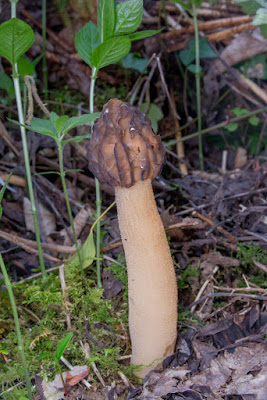Blackbridge Quarry - Wednesday 19th April 2017
This is a small attractive former limestone quarry, managed by Shropshire Wildlife Trust, to the south Llynclys Common. Eight of us met at the designated meeting point. From here we drove to a parking spot about 200 yards from the quarry, near to Crickheath Meadow. As we were getting ourselves ready one of the group got a telephone call.
"Where are you?"
Ah! We should have been ten and we (I) had left two "later" arrivals behind at the meet point.
Oops!
With suitable apologies the situation was quickly rectified and the two "latecomers" joined us a few minutes later.
We made our way to the quarry quite briskly, not stopping until we got there.
 |
| Photograph: Bob Kemp |
One of the aims of the day and first stop was to investigate a small cave near the entrance that contained cave spiders to determine which of the two species they were. We had seen the spiders on a previous visit but they were beyond our reach as the cave was guarded by an iron grill.
After our previous visit we asked the Trust if we could open the grill and enter the cave. They agreed. Unfortunately when I asked for the key a few days before our visit it could not be found. So we had to content ourselves with peering in. The good news is that there were still spiders in the cave. We will try again another day.
This disappointment was but a minor setback as we then set out to explore the delights of this site.
As it was April we did not expect to experience the full floral wonder of the quarry but there were some flowers in bloom. There was plenty of yellow from Dandelions and cowslips; a little pinkish white from Wood anemones and a Cuckopo flower. Up against one of the rockfaces:
was a Stinking hellebore with its drooping green flowers:
One of the plants growing in the loose rocks was the common maidenhair spleenwort:
 |
| Asplenium trichomanes - Photograph: David Williams |
There were plenty of spiders with the various habitats within the quarry providing their niche species. One excellent find was the BAP species spider Saaristoa firma (sorry, no photograph). But, thanks to my colleagues I do have photographs of the jumping spider Evarcha falcata:
 |
| Photograph: Bob Kemp |
And one for the aficionados - the underside of Evarcha falcata:
 |
| Photograph: David Williams |
Another arachnid found was the harvestman Megabundus diadema with rather bizarre structures around its eyes:
 |
| Photograph: David Williams |
A few other invertebrates caught our eye and camera lens.
A red ant carrying a captured springtail:
 |
| Myrmica rubra - Photograph: David Williams |
A green shieldbug:
And a pill millipede uncurling:
 |
| Glomeris marginata - Photograph: David Williams |
We were fortunate to also find a pill woodlouse and could compare the two "pills"; the millipede is on the left and the woodlouse on the right:
 |
| Glomeris marginata and Armadillidium vulgare - Photograph: Bob Kemp |
On a rock nearby was the local but widespread lichen Placidium squamulosum:
 |
| Photograph: Bob Kemp |
And so to the title of this piece - "1897, no sorry! 2013 and all that."
In a shady area of the quarry close to a log pile several large fungi were found. These were identified as Morchella semilibera. As I am spoilt for choice I include two photographs:
 |
| Photograph: David Williams |
 |
| Photograph: Bob Kemp |
A little while after the event a "miscommunication" occurred when this fungus was reported as Morchella elata. One enterprising member of the group checked this species on the NBN Atlas and discovered that it had not been recorded in Shropshire since 1897. Now that is pretty good - a first record for 124 years. So a good way to title this.
Fortunately the error was spotted and the name and title corrected. It is still a rare find but its last record for Shropshire on the NBN Atlas was 2013 a mere 120 years later. That's life!
We departed the quarry and made our way back to the cars, but like our visit to Harton Hollow we did not go home. Instead we walked a few yards down the road to Crickheath Meadow (I hope I have remembered the name correctly), part of Llynclys Common to see if it would be worth visiting in future. The answer was yes.
And in the gateway to the meadow were a couple more morels - this time the Common morel, with its rather spectacular head:
 |
| Morchella esculenta - Photograph: Bob Kemp |
Then we went home.
Thank you to Shropshire Wildlife Trust for allowing us to visit this site and to Bob Kemp and David Williams for providing their excellent photographs to supplement my more humble efforts.












































































